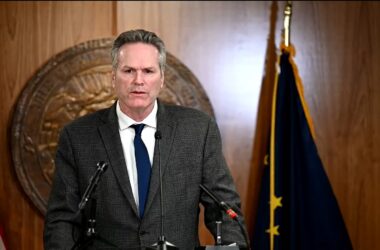Leading into the new year, KSRM will be recapping our top ten stories of 2014: exploring the issues that had the deepest impact on our community.
Many developments were accomplished for the Alaska LNG Project this year…
MARCH 17, 2014
The State of Alaska looks set to have around a 25 percent equity share in the Alaska LNG Project, including the 13 percent base tax rate for gross value at the point of production, beginning in 2022.
Sen. Fairclough(R-Eagle River): “Mr. Chairman, I move the CS for SB 138 28-gs.2806/9 from committee as ammended, and with attached letter of intent, technical drafting instructions and accompanying fiscal notes.
Chairman: “Is there objection? Hearing none, SB 138 has moved from committee. Thank you all for your hard work. Good job.”
The Senate Finance Committee finished their work on the bill last Friday, and sent it on to the Rules Committee.
Aside from financial changes, the Committee also stipulated that the Alaska Gasline Development Corporation will carry the state’s interest in liquefaction and marine terminal facilities, rather than the Governor’s proposal of creating a new subsidiary.
May 14, 2014
Leslye Langla with the Department of Commerce says only in Alaska would a 36 inch pipeline be called a small gasline, but that’s how it’s been termed in the shadow of the Alaska LNG Project.
We asked Langla how the State is working on the 36″ line…
Langla: “They’re doing their supplemental environmental work as we speak. They’re looking at holding their open season first quarter of 2015, so they’re on track to determine the feasibility of that project through an open season process, and that should happen within the next year.”
We asked Langla if it’s likely both the LNG Project and the 36″ line would be built…
Langla: “It’s probably going to be one or the other. If that small pipeline, or the 36″ which we call a mega-project, does move forward, it will require more discussion among the producers, among the State, and TransCanada to try to get together to figure out. Right now, they’re both moving forward, and the in-state gasline is the state’s ace in the hole. If the large diameter line does not move forward, or the Alaska LNG Project does not move forward, then we have a small project (or a mega-project in all senses of the word) on the horizon that we could refer to to get people gas.”
JULY 2, 2014
A formal commercial agreement has been signed by all parties of the Alaska LNG Project.
By the Alaska Gasline Development Corporation, BP, ExxonMobil, ConocoPhillips, and TransCanada signing the agreement, the project may move into its Pre Front End Engineering and Development or Pre-FEED stage.
This signing also signifies the project moving from negotiations to field work and is the furthest step Alaska has reached on a large-diameter natural gas pipeline project.
We previously reported on June 25, the above parties were waiting for ConocoPhillips to sign but Natalie Lowman with ConocoPhillips said the company was carefully reviewing the agreement to ensure it would be good for the project and good for Alaska.
The Project is in the process of acquiring somewhere in the vicinity of 800 acres of Nikiski bluffs.
JULY 21, 2014
The Alaska LNG Project has taken the next step in setting a foundation on Alaskan soil by applying for a U.S. Dept of Energy export license today.
Governor Sean Parnell applauded the announcement…
Parnell: “These companies and the state are aligned in getting Alaska’s gas to Alaskans and then to markets beyond so I’m pretty excited about the potential there, it’s the first time that we’ve been to this place and got a lot more to go but at this juncture I’m pretty optimistic.”
If approved, the license would allow the Project to export up to 20 million metric tons per year of LNG for a period of 30 years. The application hopes to export LNG to both free trade and non-free trade agreement countries.
Project Manager Steve Butt said they expect to create 15,000 jobs during construction and 1,000 operating jobs once the Project is up and running.
The proposed project facilities include: a liquefaction plant and terminal in the Nikiski area; an 800-mile, 42-inch pipeline; up to eight compression stations; at least five take-off points for in-state gas delivery; and a gas treatment plant located on the North Slope.
The project is now in the pre-front-end engineering and design phase, which is expected to be completed in 2016.
AUGUST 5, 2014
This afternoon Borough Mayor Mike Navarre will attend the first Alaska LNG Project meeting with other affected borough representatives in Anchorage.
Mayor Navarre said this is the group that Governor Sean Parnell appointed as part of Senate Bill 138.
Navarre: “One of the things I’m interested in is exactly just what kind of information we’re going to have access to and just what the purpose is going to be from this advisory group, obviously the legislation that’s going to be introduced next year will have profound effects on the Kenai Peninsula Borough and the state of Alaska and so municipal governments are paying attention and we want to make sure that we can weigh in and influence the decisions on behalf of our residents and tax payers.”
He added that he wants to make sure that those effects that will be seen are paid for through the project.
Navarre: “That’s the biggest concern is we don’t want to have a project that we are subsidizing with local taxes on residents.”
OCTOBER 1, 2014
During this week’s Legislative update on The Alaska LNG Project, Project Manager Steve Butt outlined some of the technical and social details of the proposed $45-65 billion pipeline and liquefaction facility.
Roughly 15,000 workers will be hired to build the project, with 3,500-5,000 working here in Nikiski. Butt touched on the scale of the Project and how they’re trying to incorporate Alaskans…
Butt: “Nobody’s ever built a project of the scope that we’re talking about. So you can’t go find somebody who’s done this in Alaska. Nobody has built a 17-18 million metric ton LNG plant or an 800 mile pipeline in the last 40 years, under NEPA, or a gas treatment plant. And nobody, I guarantee you, has done all three, so you gotta’ go create this capability within the contracting communities. You just couldn’t go out and say, ‘Who’s done something like this?’ There is nobody.”
By partnering contractors together, Butt says they hope to create the diverse skills they need. That means the flood of workers coming into the area will be a mix of Alaskans and migrants from other states or countries.
Senator Peter Micciche asked Butt about how the Project will help the community absorb the impacts…
Butt: “The concerns you’re talking about in terms of potentially having a lot of workers in the environment, we manage through camps and environments so that folks are moved in and out, so that we don’t have any, we limit any adverse impact on the communities. We do the design work on that in Pre-FEED and we perfect that in FEED, so that we know exactly where all of these folks will sleep at night, what kind of camps they’ll live in, where they’ll get their food, and how you do that in a way that doesn’t adversely impact the local communities and then you share those plans with the local communities so that they are also comfortable with those plans, and you do that as part of the FERC review process. And if people have concerns about that, then you incorporate that to the best of your ability.”
The Project filed with FERC on September 5th to begin that process. To read the May 7th LNG update, click here.
OCTOBER 9, 2014
The Alaska LNG Project featured in yesterday’s gubernatorial debate, where Governor Sean Parnell confirmed to KSRM that the Project is settled in Nikiski…
Gov. Parnell: “Well, because we’ve already filed the applications, this project is now dependent on Nikiski being the end point. The Project would have to file on another location if it was to go anywhere else. I’m committed to making it Nikiski. That’s what the economics say, and that’s just what makes sense. And I would point out that Bill Walker, my opponent, has spent 30 years lobbying for a pipeline to Valdez, that’s why he stood up in his first comment here and said, ‘Oh, I’ve changed my mind, I can now support a gasline to Nikiski.”
Walker had spoken of a meeting between him and then-Mayor Don Gilman when they joined together to fight for a line to Valdez…
Walker: “37 years later, that situation has reversed itself, so I don’t forget some things and I won’t do anything that’s going to slow down the process, anything that’s going to allow the process to be started over. We suffer from a land of starting over. We have started over three times in the last six years. We need to stop starting over. We need to finish something. I’ll be the governor that finishes the project.”
OCTOBER 28, 2014
The Governor has been pursuing two gasline projects at once, and one project fears Bill Walker will cut their funding if elected.
The Alaska Stand Alone Pipeline (ASAP) would deliver natural gas from the North Slope to Point MacKenzie, with a 30-mile lateral line between the main pipeline and Fairbanks. It differs from the much larger Alaska LNG Project in size and export potential.
The pipeline would carry up to 500 million cubic feet per day of consumer grade “lean gas,” which is immediately available for consumer use.
Leslye Langla with the Department of Commerce says it’s unlikely that both the ASAP and Alaska LNG Project will go ahead…
Langla: “Right now, they’re both moving forward, and the in-state gasline is the state’s ace in the hole. If the large diameter line does not move forward, or the Alaska LNG Project does not move forward, we have one the horizon that we could refer to, to get people gas.”
However, the ASAP Community Advisory Council says they’re “disappointed” Walker is “focusing entirely on a large export line to Asia.”
The ASAP Council insists there “a real chance” the LNG Project won’t find the right market for export and the State’s only option will be the ASAP.
Walker says it’s time to cut unnecessary studies, and that the ASAP started in response to a proposed shortage in the Cook Inlet, which is no longer an issue…
Walker: “We’ve been doing, studies upon studies upon studies. I will go through and determine what projects are realistic that we can do and which ones we can’t and I’ll stop the studies of those that make no sense at all.”
Walker says the market for the Alaska LNG Project is there, but the current administration has ignored the opportunities.
DECEMBER 17, 2014
A federal office which was helping in the organization of research for the proposed Alaska LNG Project is scheduled to shut down due to the budget the U.S. Congress passed last week.
Larry Persily with the Federal Office for Alaska Gas Line Projects said funding for their office was not in the budget.
Persily: “We have some left over money that we had not spent in previous year and we’ll be using that for an orderly shutdown of the office, making sure that the information we’ve compiled is archived, is available to the public, doing as much as we can to make sure the reports and information that we have produced, gathered and put on the web will be available for the public to see after we’ve closed. It’s going to take 2 or 3 months and then we’ll close the doors.”
Persily said he doesn’t expect the closure of his office to affect the progress of the LNG plant, as it will be built if it is economically viable.
Persily: “The market will determine if the project is built or not, whether we’re there or not. I do believe that a project this big, this complex, we could have helped but I believe federal agencies, fish and wildlife service, BLN, EPA, the nation marine fishers, are capable, very capable of doing the job, I think we could have helped. Same thing for Exxon, Conoco and BP, I think we could have helped them navigate some of the issues.”
He presented information on the Alaska LNG Project to a joint Kenai Soldotna Chamber luncheon in October where he called on the community to stay involved in the process and read the reports released by his office.
Persily said personally he will do as much as possible to make sure all the information on the project remains available after they shut down.






